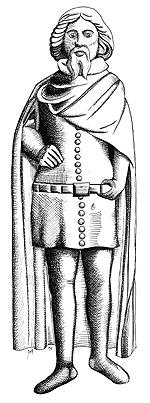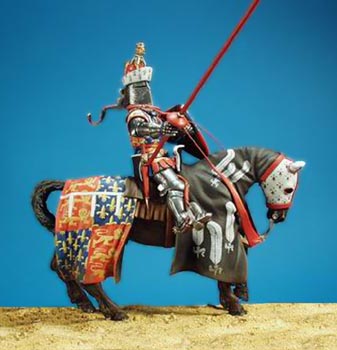 |
 |
|||
|
|
Prince Edward, the eldest son of King Edward III and Queen Philippa of Hainault, was born at the Royal Palace of Woodstock in Oxfordshire, on the 15th June 1330. In his third year, he was created Earl of Chester; four years afterwards Duke of Cornwall; and, in 1343, Prince of Wales. At the institution of the Order of the Garter, Prince Edward had not completed his fourteenth year; and, although included amongst the Founders, in accordance with the design of his royal father that the eldest son of the Sovereign should be always a constituent ember of the Order, the honour of knighthood was reserved for the moment when he should be armed and thereby qualified to enter upon his warlike course. This occasion presented itself when, accompanying the King on his memorable expedition against France, he landed at La Hogue on the 12th July 1346. At the Battle of Crécy, which was fought on the 26th August following, King Edward, desirous that his noble son should "win his spurs," gave him the command of the van, with the counsel and assistance of the Earl of Warwick and Sir John Chandos. The tradition near the spot is, that the King had ordered the Prince to wear, on that day, a black cuirass, richly ornamented; and that, from this incident, he retained the surname attributed to him in history. The defeat of the enemy is known to have been complete; and the delighted father, embracing his son on the field of victory, eulogised his valour and pronounced him worthy of empire. The magnificent establishment provided for Prince Edward in his early infancy, by his investiture with the ample domains of the County Palatine of Chester and the Duchy of Cornwall, had placed a vast revenue at his disposal as soon as he arrived at an age to administer his own affairs; and we have contemporary testimony of the brilliancy of his court, not only during his residence in England, but especially whilst exercising the supreme authority in Aquitaine. From a highly interesting volume, unknown to his various biographers, and containing the warrants and accounts of the treasurers and other officers of his household from 1346, and, in a regular series from February 1351 to November 1365, we learn that, upon his return from Calais, in 1347, his town residence was "Pulteney House," situated in or near Candlewick Street, in the parish later called St. Lawrence Pountney in the City of London. This mansion, which had been erected, by Sir John Pulteney (who frequently filled the civic chair), on the site of the later Cold Harbour Palace, is described as having been built on a scale of great splendour. It was, at some time after the death of Sir John, which happened in 1340, and during the minority of his son, tenanted by the Prince, until 1359, in which year directions were given to surrender it to Sir Nicholas Loveyne, who had married the knight's widow. Its front was open to the Thames, where the prince kept swans in considerable number, to which allusion is often made in these accounts. The Prince's country residences appear to have been chiefly Berkhamstead Castle (Herts), Wallingford Castle (Berks), Northbourne near Sandwich (Kent), Byfleet (Surrey) and Kennington Manor (Surrey) near London. The above-mentioned volume abounds with proofs of the generous use which Edward made of his wealth in the distribution of costly presents amongst the members of his august family, his gallant companions in arms and his numerous retainers, as well as in princely guerdons to strangers of every rank who had the fortune to attract his regard. At the expiration of the truce with France, on the 24th June 1355, he began to prepare for his departure for Gascony, invested, as the King's lieutenant, with the government of all his French possessions. By an indenture dated at Westminster 10th July in that year, made between the King, on the one part, and the Prince of Wales, on the other, it was stipulated that the Prince should be attended by 433 men-at-arms and 700 archers, of whom 400 should be mounted and 300 on foot; which force - as well as the men-at-arms and archers of the Earls of Warwick, Suffolk, Oxford and Salisbury, Sir John de Lisle and Sir Reginald de Cobham - should constitute the proper retinue of the Prince, and be paid by the King for one half-year in advance, reckoning from the day of their embarkation; and, for carrying into effect the several provisions of this agreement, the Duke of Lancaster, and the Earls of Northampton, Arundel, March and Stafford, pledge their loyal aid and counsel. The Prince appears to have had his headquarters at Plympton (Devon) from 8th August until 2nd September, and to have issued, from thence, several warrants to his treasurer and other officers in London. On 4th of the latter month, we find him at Plymouth (Devon). On 7th, there is a warrant for vestments for the priests of his chapels at Wallingford and Berkhamstead; gifts of musical instruments to the minstrels sent to him by the Count of Eu; and for the cost of "a round plate, gilt and enamelled with the arms of the company of the Garter, which we gave to William de Stafford, Herald of Arms, and of three garters, the one of gold, the other enamelled with an eagle and the third, a common silver garter, enamelled and gilt, which we have received for our own use."
After the proofs given by the Prince, during his government in Aquitaine, of his talents, not only as a military commander but as a statesman, he appears to have borne an important part in the direction of public affairs. By an instrument, dated London, 6th September 1357, he appointed Henry, Lord Percy and Ralph, Lord Neville to swear on his behalf to the observance of the treaty to be concluded between the King, his father, and his council and the prelates, nobles and others of the Kingdom of Scotland, concerning the liberation of "David de Bruys, a prisoner of our Lord the King." In 1362, the King created his victorious son, Prince of Guienne and Gascony, and erected those provinces into a principality for the term of his life. Edward proceeded immediately to his new territories, accompanied by his princess; and held his court with great state and magnificence at Poitiers, to which city the barons and knights of Poitou and Saintonge repaired, to do him fealty and homage, and where he was also visited by Peter de Lusignan, King of Cyprus. On the latter occasion, the Prince gave a Royal joust of forty knights and as many esquires in honour of the birth of his son, Edward. During the residence of Prince Edward at Bordeaux, his aid was personally solicited by Peter "the Cruel," King of Castile, towards the recovery of his kingdom, from which he had been driven by his illegitimate brother, Henry of Transtamare. King Edward concurring, the Prince entered Spain at the head of 30,000 men and, after a severe contest at Najara (about fifty miles south of Bilboa) on 3rd April 1366, restored the ungrateful monarch to his throne. From this expedition, Edward is said to have returned to Bordeaux with the seeds of a malady which never quitted him. His spirits having also suffered great depression from the loss by death of his eldest son, Edward, he left the prosecution of the continental war to his brothers, the Duke of Lancaster and Earl of Cambridge, and, embarking with the Princess and their only surviving child, Richard, arrived at Plymouth in January 1371. Two years afterwards, he surrendered the principality of Guienne into the King's hands and, from that period, seems to have taken little interest in public business; exhibiting a melancholy example of the instability of all human glory. He made his will, in the King's Great Chamber at Westminster, on 7th June 1376; and, to the great grief of the nation, expired there on the day following. His body, having been embalmed, was kept until the meeting of Parliament at the ensuing Michaelmas, in order that it might be interred with the greater solemnity. This was performed at Canterbury, near the shrine of St. Thomas A'Becket; and a stately monument, still extant, was thereupon erected to his memory. By his consort, Joan, who in her youth had been named the "Fair Maid of Kent," the sister and heir of John Plantagenet, Earl of Kent, and relict of Sir Thomas Holland, in her right, also Earl of Kent (to which lady the prince was married in the Royal Chapel of St. George at Windsor Castle (Berks) on Sunday 10th October 1361), he had two sons, Edward, born at Angoulême on 27th January 1365, who died at Bordeaux, in the sixth year of his age; and Richard, afterwards King Richard II. Edited from George Frederick
Beltz's "Memorials of the Most Noble Order of the Garter" (1841)
|
|||
| © Nash Ford Publishing 2001. All Rights Reserved. | ||||




